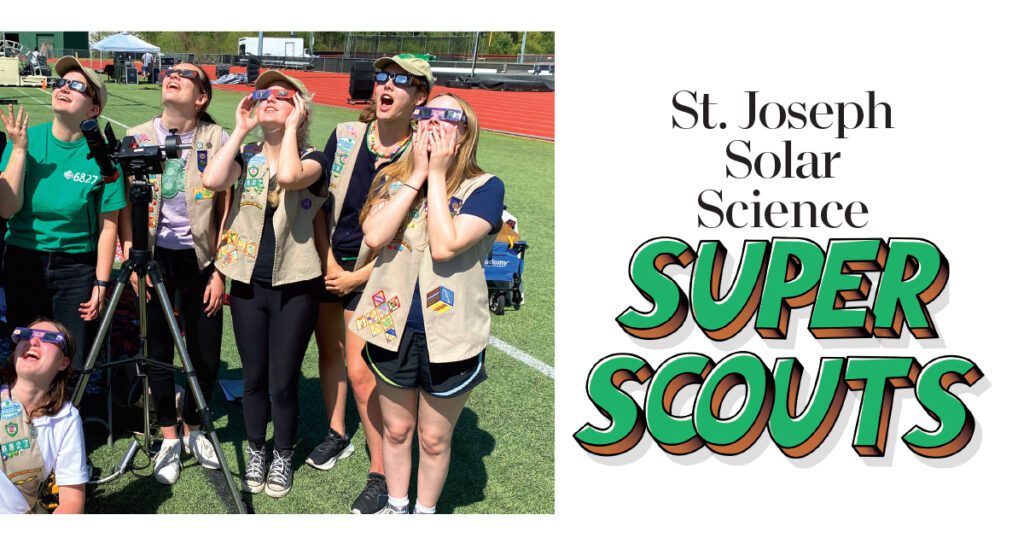30 Apr 2024 501Der Women 2024: St. Joseph Solar Science Super Scouts
By Carol Rolf
Members of Girl Scout Troop 6827 joined the crowds of people viewing the total solar eclipse April 8 at Hendrix College in Conway. However, they were not just there to “ooh” and “aah” at the rare sight, but were serving as citizen science investigators collecting data to help scientists better understand the sun.

Members of the troop, based at St. Joseph School, include eighth-grader Brileigh Choate; sophomores Aubrey Michaels, Addison Choate, Izzy Simon, Peyton Mangum and Amelia Erstine; and senior Carolina Ferrer. The troop was among 19 youth-serving organizations selected by Cosmic Picture (based in London and New York) to participate in citizen science investigations leading up to and during the total solar eclipse as part of its Einstein’s Incredible Universe media and education project. The citizen science program is executed in partnership with Southern Illinois University (SIU) at Carbondale and its Dynamic Eclipse Broadcast Initiative, and it is funded by the National Science Foundation and NASA. The Great Lakes Science Center at Cleveland, Ohio, provided equipment and training on how scientific data about the eclipse could be retrieved. The troop’s leader, Karen Ferrer, traveled to the Great Lakes Science Center in November 2023 for that training and to acquire the Scouts’ telescope that would be used to collect data. The Scouts began practicing with the telescope soon afterwards.
The troop was invited by Hendrix physics professor Ann Wright to collect the data during the college’s Solar Odyssey event scheduled at the college’s Young-Wise Memorial Stadium from noon to 4 p.m. April 8.
“We arrived at 10 a.m. to begin setting up,” said Ferrer, who teaches math and chemistry at St. Joseph and is a former Girl Scout. “That gave us two hours to troubleshoot. By noon, we were ready to go, and I told the girls to go have lunch. They did, and when they came back, we pressed ‘go’ on the telescope and nothing happened. We rebooted and tried to start over…nothing. We tried again…nothing. It was one of those computer things. So, we missed the start of the partial eclipse for about 15 minutes. We finally got it going and then we had to change programs to record the total eclipse, and we lost the sun. It was just gone. We got that fixed just as totality began, and the sun appeared, covered by the moon.
“It was awesome, an incredible moment,” she said. “I couldn’t be more proud of these girls. There were some stressful moments when things were not going according to plan. They stayed calm and kept trying. In the end, they were able to be successful because of perseverance and teamwork.

“The day was a rollercoaster of emotion from the nervous energy of the morning, through the panic when things weren’t working, to the amazing sense of accomplishment at the end of the day,” Ferrer said.
Brileigh Choate said she would “remember April 8, 2024, forever. It was such a cool experience to be able to see an eclipse in totality, let alone photograph it for research. Not even scientists get perfect results when researching. You just have to not give up, even if your telescope starts spinning and won’t stop.”
Brileigh’s older sister, Addison Choate, said, “This is an experience I couldn’t forget. I learned so much about space and I hope to learn more in the future. People were really interested in what we were doing. I got to talk to people from around the country and teach them new things and learn new things as well.”
Ferrer said they have sent the data and photos to SIU, where they will be studied over the next months, “maybe even a year or two. There were other groups doing the same thing even in areas where it was just a partial eclipse, not in the path of totality. Scientists will line all of that up as they analyze the data. The sun is so bright that it can only be studied during an eclipse when the moon blocks it.
“These girls will be co-authors of scientific research published in scientific journals,” Ferrer said, smiling. “We now have a telescope. We might be able to take part in other citizen science projects. I am so happy to share my love of all things space science with a new generation of girls. I hope that they have a new perspective on their place in the universe and how unique and beautiful the world is.”








